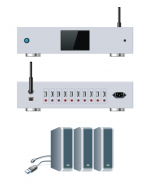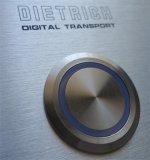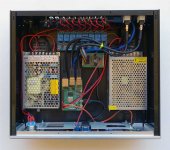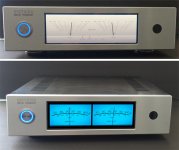I have several external USB hard drives with audio and video. I'd like to make NAS and connect them to that NAS so that the drives would be visible on my home network.
Is it also possible to combine NAS and Streamer functionality? Is it really required to use a dedicated OS (e.g. OpenMediaVault) or it's possible to make NAS without it using just the regular OS (e.g. Raspberry Pi OS)?
For the hardware I think to use:
Is it also possible to combine NAS and Streamer functionality? Is it really required to use a dedicated OS (e.g. OpenMediaVault) or it's possible to make NAS without it using just the regular OS (e.g. Raspberry Pi OS)?
For the hardware I think to use:
- Raspberry Pi 4
- Powered USB Hub to connect external hard drives
- Relay board to switch on/off external hard drives
- Small touchscreen if the system will have the Streamer
Attachments
OMV can run on top of Raspberry Pi OS. There's a download specifically for that.
OMV makes managing your NAS very beginner friendly...🙂
Rather than drives each in its own enclosure look at a dedicated multi-bay enclosure with fan cooling such as the Orico NS-USB3.0 series.
ORICO 8 Bay 3.5 inch Type-C Hard Drive Dock (NS800C3
OMV makes managing your NAS very beginner friendly...🙂
Rather than drives each in its own enclosure look at a dedicated multi-bay enclosure with fan cooling such as the Orico NS-USB3.0 series.
ORICO 8 Bay 3.5 inch Type-C Hard Drive Dock (NS800C3
Last edited:
DRONE7, thank you for reply. I'd like to use the hard drives as is without removing them from the enclosures so that I could easily move those hard drives around.
I think the maximum number of users for the NAS/Streamer will be 3. I'm not sure if Pi 4 is capable to handle 3 SD video streams. I should probably try several options suggested here for the media server:
7 Ways to Set Up Your Raspberry Pi as a Media Server | MakeUseOf
All hard drives are in NTFS format and I don't want to re-format. Hopefully I can also use them as is.
I think the maximum number of users for the NAS/Streamer will be 3. I'm not sure if Pi 4 is capable to handle 3 SD video streams. I should probably try several options suggested here for the media server:
7 Ways to Set Up Your Raspberry Pi as a Media Server | MakeUseOf
All hard drives are in NTFS format and I don't want to re-format. Hopefully I can also use them as is.
Last edited:
phofman, they are just regular external hard drives. The regular usage will be when only 1 maximum 3 (3 users using different disks) of them will be spinning. Hopefully that's not so noisy.
Is there any principal difference in NAS and Streamer functionality? In case of Streamer several users can connect and watch/listen the same file. Is it less overhead than if the same users will just pull the same file from the NAS? I'm still trying to understand if I really need the Streamer functionality?
Is there any principal difference in NAS and Streamer functionality? In case of Streamer several users can connect and watch/listen the same file. Is it less overhead than if the same users will just pull the same file from the NAS? I'm still trying to understand if I really need the Streamer functionality?
I would not want a rotating 3.5" drive in my listening place, seeking is audible, but YMMV.
Typically NAS serves raw files over network from its local storage, while streamer serves network audio/video streams from its local storage or internet, or feeds USB-audio directly. All are mostly linux (or BSD with ZFS for some NASes, but BSD has adopted the linux OpenZFS driver recently). A single machine can do all of that (plus lots more).
IMO the reason people use the separation are the rotating drives which should be cooled a bit for permanent operation - i.e. noise reasons. And of course commercial - different producers of NASes and streamers.
Typically NAS serves raw files over network from its local storage, while streamer serves network audio/video streams from its local storage or internet, or feeds USB-audio directly. All are mostly linux (or BSD with ZFS for some NASes, but BSD has adopted the linux OpenZFS driver recently). A single machine can do all of that (plus lots more).
IMO the reason people use the separation are the rotating drives which should be cooled a bit for permanent operation - i.e. noise reasons. And of course commercial - different producers of NASes and streamers.
people use the separation are the rotating drives which should be cooled a bit for permanent operation - i.e. noise reasons.
Exactly !
.A single machine can do all of that (plus lots more)
🙂🙂
Why not re-purpose an older Desktop with Sata for server drives and USB3 for backup..? OMV and headless operation..😉
Sure, hard drives produce some noise. I would compare that noise with noise produced either by reel tape recorders or compact cassette players 🙂 If it's too distracting then the NAS should be placed somewhere outside of the listening space something like basement.
Regarding heat, I use similar system based on WD TV player for about 10 years and never had any issue with overheating of the external hard drives even when it works the whole day.
As I said I'd like to use Pi 4 as I'm more comfortable with it. Also it's silent when it works with passive cooling. Also it doesn't need large Power Supply which usually also has a fan inside which is another source of noise.
What's the benefit of using OMV vs just sharing disks (NAS) and starting VLC in streaming mode (Streamer)?
Regarding heat, I use similar system based on WD TV player for about 10 years and never had any issue with overheating of the external hard drives even when it works the whole day.
As I said I'd like to use Pi 4 as I'm more comfortable with it. Also it's silent when it works with passive cooling. Also it doesn't need large Power Supply which usually also has a fan inside which is another source of noise.
What's the benefit of using OMV vs just sharing disks (NAS) and starting VLC in streaming mode (Streamer)?
I was in a similar predicament 3-4 tb usb drives , WD player. I built a Linux server from a mini Itx board. It crashed a couple time trashing everything. I purchased a Qnap server and it manages things pretty well, raid redundancy local backups and runs Plex server. I can even connect to it remotely. I had a I5 nuc laying about and put it into Roon service with the media on the Qnap. The Qnap used to reside in the living room and it was annoying, so I moved it in the closet with the house router.
Good luck
Bill
Good luck
Bill
I've just found the following article about Volumio Primo player:
Volumio Primo – DigiPhonix
In the section 'USB output to external DAC' it's saying Pi 3B+ USB output to external DAC is not so good. I'm just wondering what makes Pi USB output not so good? If it's really not so good, is there any way to improve it?
Thanks!
Volumio Primo – DigiPhonix
In the section 'USB output to external DAC' it's saying Pi 3B+ USB output to external DAC is not so good. I'm just wondering what makes Pi USB output not so good? If it's really not so good, is there any way to improve it?
Thanks!
If it's really not so good, is there any way to improve it?
Thanks!
RPi4. The USB bus on the 4 is unique, that on previous Pi's is shared with ethernet.
If it's really not so good, is there any way to improve it?
For RPI versions <4 get a HAT or a DAC.
I can confirm on an RPI4B there are no noises what sound concerns and I use it on a WIFI connection. Sound is fine also connected to amp, but I'm not an audiophile.
Yes, I'm aware of hdparm and udiskctl. I'm not sure that they work for disks connected through the USB Hub. That should be verified.
Last edited:
I have a toshiba USB 3 that I use for backups that spins down. Check before you go to the efforts
Sure, another point to consider - if I switch the system off and then on again all disks will have 12V power if I don't use relay. So all of them will start working (?) There are many use cases which I need to check...
That looks amazing work!
Quite industrial looking
In my projects, I've found panel connectors/jumpers where I can have the hole custom cut for each
S
Quite industrial looking
In my projects, I've found panel connectors/jumpers where I can have the hole custom cut for each
S
- Home
- Source & Line
- PC Based
- NAS + Streamer







